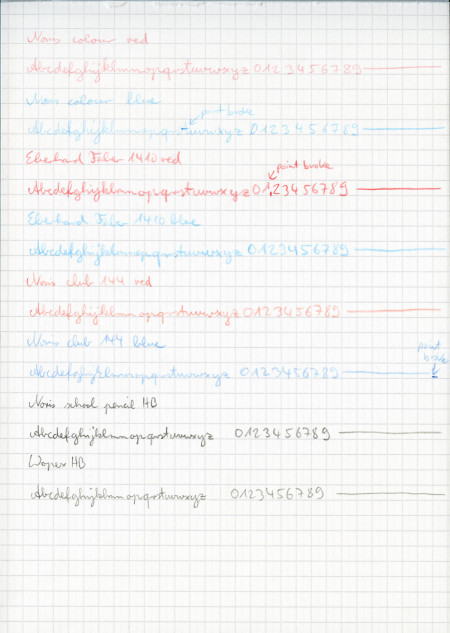Noris colour wear and tear
Introduction
Here’s my first follow up post about the Noris colour, the coloured pencil made using Wopex material, which has been mentioned in a previous blog post. I bought my set of six Noris colour for £2.49 (~$3.76; €3.46) on eBay. There are also sets with 12 and with 24 pencils available.
As explained earlier I have been looking for a coloured pencil, one that is suitable for writing, for quite a while now. The Noris colour is one of the best pencils for this purpose I have seen so far.

The test
Now this is not a scientific exploration of how fast the lead will wear down, I have neither equipment nor experience, but just to give you some rough idea what I did:
- The average normal pen force used to write the sample lines was approximately 1 Newton. I don’t know the average axial pen force. There was obviously a lot of variation as I wrote by hand – with more force being used for downward strokes. As you can see the point broke a few times. It would be great to have a pencil hardness tester, like the Elcometer, to make these tests more objective [1]They’re actually supposed to the the surface you scratch with the pencils, not the pencils themselves. I guess I should either start a Kickstarter (think potato salad) to try to get my hand on … Continue reading.
- All pencils were sharpened using the Deli 0668, i.e. with an angle of approximately 20°. The Deli was dialled back one full rotation (360°) do avoid creating a point that will break too easily.
- The paper used was from a Brunnen – Der grüne Block (previously seen in this post)

Before
All pencils, the Noris colour, the Eberhard Faber 1410 and the Noris club 144, had an initial line thickness of 0.1 mm – 0.3 mm (vertical / horizontal variation).
After
The point of the Noris colour wore down the least. After one line of writing the line variation was 0.3 mm – 0.5 mm.
The point of the Eberhard Faber 1410 wore down the most. After one line of writing the line variation was 0.5 mm – 0.6 mm.
The point wear of the Noris club 144 was in the middle. After one line of writing the line variation was 0.3 mm – 0.6 mm.
Conclusion
The Noris colour performed best. Subjectively the point felt better than what the numbers suggest, but then the Noris is also the pencil that left the lightest mark. The Eberhard Faber 1410which wore down fastest left the strongest marks on paper.
Despite the light marks the Noris colour is in my opinion the best pencil for writing or marking. It is also easy to erase.
Price Noris colour: February 2015.
I bought the Brunnen notepad in August 2011 in McPaper, Schweinfurt (Germany) for €1.19 (~$1.29; £0.86).
I bought the Noris Club pencil in 2008 from Woolworths went they into administration. I don’t remember the price.
I bought the Eberhard Faber pencils in 2010. More information about them can be found in this blog post.
Exchange rates: March 2015.
References
| ↑1 | They’re actually supposed to the the surface you scratch with the pencils, not the pencils themselves. I guess I should either start a Kickstarter (think potato salad) to try to get my hand on a pencil hardness tester or try to build my own one. |
|---|
Noris colour wear and tear Read More »





